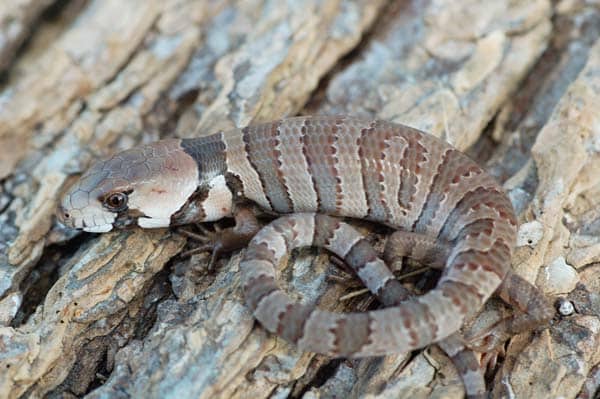Tips on caring for Hemisphaeriodon gerrardii.
Overall, skinks have steadily gained popularity in herpetoculture. Of all the skinks, blue-tongued skinks (genus Tiliqua) are by far the most popular due to several inherent features, including being large in size, slow moving, fairly docile in temperament, as well as being easy to maintain and reproduce. Other skinks, such as the fire skink (Riopa fernandi), the prehensile-tailed skink (Corucia zebrata) and the crocodile skink (Tribolonotus gracilis) have unique qualities that make them particularly interesting and well-suited for the hobbyist. However, there is one skink — noted for its attractive pattern and undemanding nature in captivity — that is becoming an increasingly popular skink in the hobby. The pink-tongued skink (Hemisphaeriodon gerrardii), known for its namesake pink tongue, is a much-coveted species on the American herpetocultural scene.
A True Aussie
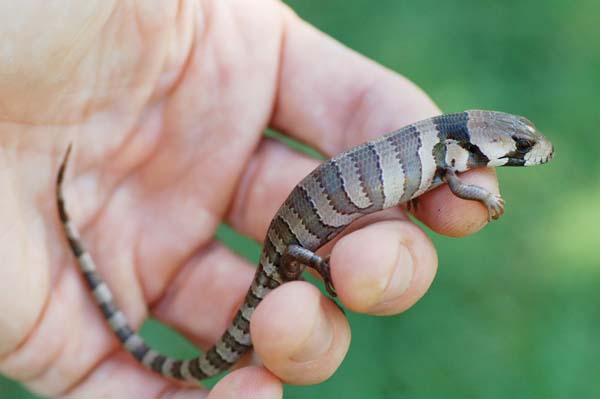
A juvenile pink-tongued skink will retain its dark mask, but the prominent body pattern begins to lighten at 4 to 6 weeks of age.
Australia is home to a tremendous variety of reptiles, and the skinks play second fiddle to none when it comes to diversity. More than 300 skink species occur in the Land Down Under, including the interesting resident that is the subject of this article. Taxonomically in turmoil for years, before being placed in the genus Hemisphaeriodon, the pink-tongued skink was placed within the Tiliqua genus, the same as its larger azure-tongued relatives, the blue-tongued skinks. Certain physical attributes also led the pink-tongued skink to be associated with the slender skinks of the Cyclodomorphus genus, another close relative of the blue-tongued skinks.
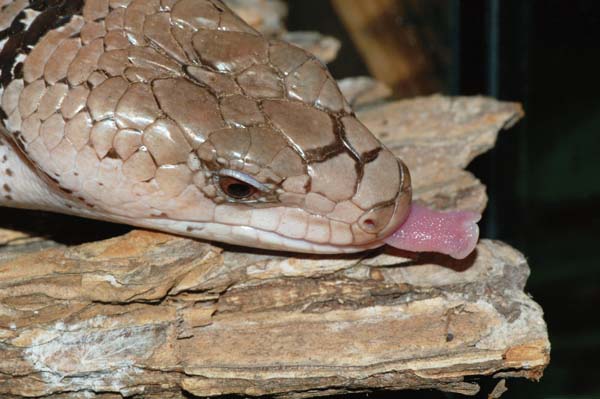
Pink-tongued skinks do well at temperatures in the upper-70s to mid-80s degrees Fahrenheit for most of the year. A basking area should reach into the low-to-mid 90s range.
Found in eastern Australia, from the southern Cape York Peninsula to New South Wales, the pink-tongued skink occurs in both coastal and upland habitat. At home on the ground as well as in low vegetation, the pink-tongued skink frequents wet sclerophyll forests, rain forests and moist woodlands. Hiding within logs and underneath leaf litter during the day, it tends to be crepuscular to nocturnal. Considerably more slender, but only slightly shorter than your average blue-tongued skink, the pink-tongued skink averages about 17 inches in length, of which half consists of its lengthy prehensile tail. Attractively patterned, it is typically a light-brown to silver-gray color, with a series of dark-brown to black crossbars traversing down its entire dorsum. Completely patternless individuals are known, and there appears to be a variance in color within its range, with more silver and black individuals being found in the New South Wales area. However, even within a single litter, the variation can be significant. The skink’s common name obviously refers to one of its most prominent features: its pink tongue.
Housing for Pink Tongues
Pink-tongued skinks are surprisingly easy to maintain in captivity, and this is one reason, as well as being attractive and docile, that makes this Australian lizard a much-wanted herp. An adult pink-tongued skink can be comfortably housed in an enclosure the size of a 10-gallon aquarium, but larger cages will allow the skink room for more exercise as well as additional hiding places. Hiding places are especially important when housing more than one animal together. Given that they will fight, I suggest maintaining these skinks separately and only introducing them under a watchful eye. The option of communal housing may work for pairs or multiple females, but males should never be kept together because serious injuries may result.
There is no steadfast rule for substrates used in pink-tongued skink enclosures, but they do like to burrow. While I favor cypress mulch for its moisture-retention qualities, other possibilities include soil, aspen shavings or bark chips. In the wild, pink-tongued skinks have a propensity to climb, so the addition of vertically oriented pieces of cork bark or branches will be appreciated.
Always offer a water bowl. I tend to slightly overfill their water bowls, letting the water flow into the substrate — a great aid when the skinks need to shed. Although humidity is not an overall critical factor in maintaining this fascinating lizard, an occasional misting of the cage has the wonderful effect of stimulating them to actively search their surroundings for food.
I suggest using an ultraviolet light source when keeping pink-tongued skinks. While there is no evidence, to my knowledge, that Hemisphaeriodon gerrardii needs UV lighting for successful maintenance and calcium assimilation, an occasional individual may develop physical abnormalities that suggest metabolic problems, so why take the chance? Fluorescent UV bulbs are relatively inexpensive and are easily purchased from a variety of businesses that cater to the reptile hobbyist. Place the fluorescent bulb within a few inches of the enclosure’s screen top to allow the maximum amount of UV to enter the cage. A basking lamp should also be provided. Place the lamp immediately above an appropriate area, such as a branch or vertically positioned piece of cork bark. It is important to use an appropriate bulb wattage; you want to heat a specific area but not the entire cage. Pink-tongued skinks do well at temperatures in the upper-70s to mid-80s degrees Fahrenheit for most of the year. The basking area should reach into the low-to-mid-90s-degree range. Do not use hot rocks, as they may result in thermal burns to the skink.
Unlike some blue-tongued skinks and most prehensile-tailed skinks, which bite quite readily and hard, pink-tongued skinks are in my experience one of the most docile and easy to handle of all the skinks. Rather slow in movements as adults, they are easily picked up and do not have the propensity to lose their tails, a rather common attribute of faster moving skinks, including the North American skinks of the genus Eumeces. As with most reptiles, however, handling should be kept to a minimum to avoid the possibility of potential stress to your pink-tongued skink.
Bon Appetite
In the wild, pink-tongued skinks relish snails and slugs. To accomplish the task of crushing the snail shells, they possess large, flattened teeth in the rear of their mouths on both the upper and lower jaws. Wild-collected snails and slugs, however, should be fed sparingly in captivity due to the potentially harmful parasites and garden pesticides they may harbor. Additionally, feeding snails collected from areas planted with oleander trees and other poisonous plants has been known to result in pink-tongued skink fatalities. Frozen snails, available in some Asian grocery stores where they are sold for human consumption, are a potential alternative.
Fortunately, captive pink-tongued skinks will usually feed quite readily on more easily available food items. In captivity, this species will eat a variety of foods including, but not limited to, earthworms, waxworms, mealworms, bananas, mice, cat food, dog food, chicken and beef. I have found that pink-tongued skinks will feed quite readily on Mazuri’s omnivore diet. The omnivore diet is produced in a dried-biscuit form and is easily softened when soaked in water. I mix a small amount of beef dog food with the omnivore diet at a 3:1 (omnivore diet: dog food) ratio and supplement every second to third feeding with a light dusting of calcium with D3 and a reptile vitamin. Once a week, dead pinks are offered to the skinks and generally eaten with relish. All food is offered on small plates, which are left in the enclosures overnight.
Reproduction
Breeding the pink-tongued skink is actually quite easy, but a close eye on the proceedings is strongly recommended. Having multiple males and females will help to ensure success. I have found that some males show little to no interest in breeding while others are extremely proficient at this endeavor. The same can be said about females. While a particular female may breed, she may not produce, while others seem to be particularly fecund.
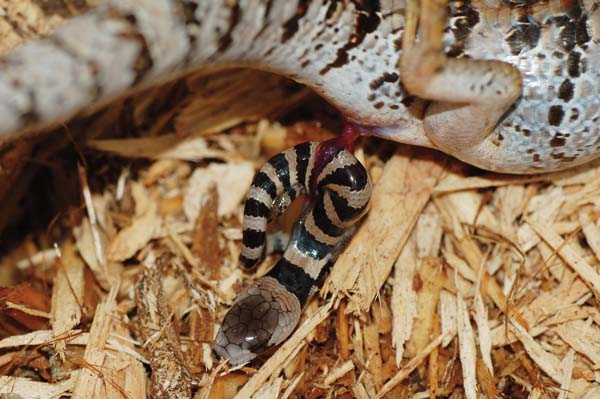
The birthing process is quite dramatic, with baby pink tongues being born at several-minute intervals.
The range of the pink-tongued skink encompasses both temperate and tropical climates. As such, considerable variation in seasonal temperatures exists depending upon where the skink came from. Pink-tongued skinks from the southern portion of the range are exposed to lower temperatures during the winter and may remain inactive for longer periods of time than those hailing from the northern portion of the range. Although captive pink-tongued skinks have successfully produced young with little to no thermal cycling, it is probably a good idea to provide some seasonal variation in temperatures. To accomplish this, temperatures should be lowered during the winter over the course of a week or two, a few degrees at a time, with nighttime lows reaching the mid-to-lower 60s degrees Fahrenheit and daytime temperatures reaching the upper 60s to lower 70s. During this cooling period, overhead lighting should either be turned off or kept very low. It is imperative to not feed your animals a week or so before actually cooling them down and to provide a water dish at all times during the cooling period.
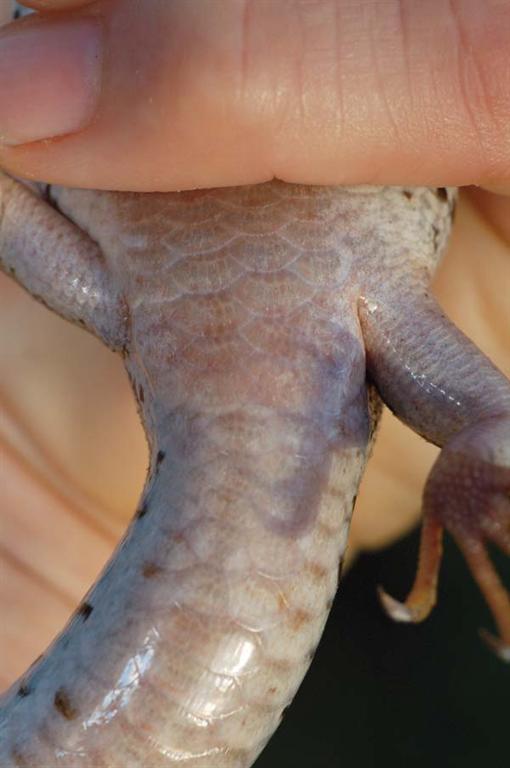
Femailes relatively have a straight tail
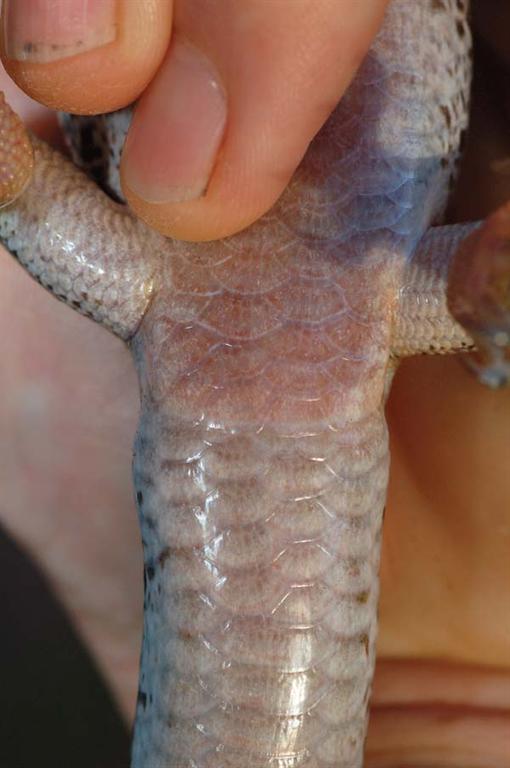
Males have a more prominent tail base and lateral hemipenal protrusions
After a two- to three-month cooling or brumation period, slowly begin raising the temperature and lighting levels over a couple of weeks, several degrees at a time until temperatures and light return to pre-brumation levels. Begin feeding the skinks within a week or two after temperatures return to pre-brumation levels. Approximately a week or two after they begin feeding again, start pairing the skinks together with a watchful eye. I prefer to place a female in the male’s enclosure. Initially, the females may bite him and attempt to escape the male’s amorous advances. If this happens and the female’s behavior becomes too violent, it may be necessary to separate the skinks. The female may not be ready to mate, and it is best to wait for another time to introduce them again several days later. Eventually, the female may acquiesce and allow a male to mate with her. Males typically will grasp or bite the female near the shoulder area before copulation takes place. Copulation lasts for a minute or two.
The gestation period is approximately three to four months and may vary according to temperature. As a general rule of thumb with most reptiles, there appears to be a correlation between temperature and gestation period. Cooler temperatures may result in longer gestation periods, but if the temperatures are too cool or too warm, deformities and/or stillborn young skinks may result. Females will actively bask during this period, so a basking area should be provided that will allow temperatures approaching the upper 90s to be achieved. It has been my observation that females tend to eat less or go off feed completely a week or so before giving birth.
Litter size ranges from about five to 67 (yes, an eye-popping 67) young, but most pink-tongued skink litters average about 10 to 20. The birthing process lasts anywhere from 20 minutes to more than an hour in length, depending upon the litter size. Neonates are passed one by one, usually with an interval of several minutes between each birth. The neonates immediately eat their afterbirth within minutes of being born. To avoid any problems, transfer neonates as soon as possible to individual cages. Females have been observed eating infertile ova after the birthing process.
Neonates are born with a highly contrasted pattern, which changes to more of an adult coloration within two to three months after birth. As previously mentioned, neonates, which tend to be somewhat skittish at first, should be housed individually to avoid potential aggressive behaviors and stress. Food, the same as offered to the adults but in smaller portions, should be offered every one to three days.
The pink-tongued skink, an awesome lizard from the Land Down Under, makes an ideal pet for both beginners as well as advanced reptile keepers. This skink generally reaches maturity within two to three years and can be maintained in a relatively small enclosure, but as previously mentioned, larger cages will offer greater exercise and hiding places. With their striking patterns, docile behavior and ease of maintenance, the pink-tongued skink should be on everyone’s must-have list. REPTILES
Sexing Pink-Tongued Skinks
Adult pink-tongued skinks are relatively easy to accurately sex, but only when a group of similarly sized animals are available for comparative purposes. Several sexually dimorphic characteristics are visibly apparent in adult skinks, but as juveniles, these features are nowhere near as evident. For one, males typically have larger heads than females. General body shape is another telltale feature, with females having more rounded lower abdomens than males. A third feature is the more prominent tail base and lateral hemipenal protrusions of the adult male when compared with the relatively straight tail of the female. Finally, males are said to be more heavily banded as adults, but I have found that considerable variation exists among individuals of both sexes.
R. Michael Burger is a writer, artist, photographer and avid herpetoculturist with more than four decades of experience. His pen-and-ink drawings, photos and articles have appeared in a variety of American and European publications, including books and magazines.

